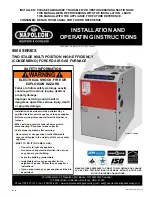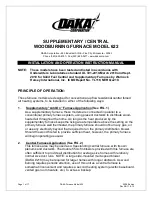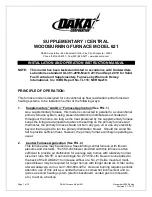
51
F
AULT
C
LEAR
S
EQUENCE
:
•
Only allowed in standby mode, while display is showing ON.
•
Hold fault recall push-button for 5-10 seconds (until display starts flashing “—”) and then release.
•
All faults in the history will have been cleared, and display returns to ON.
•
If you hold the button for longer than 10 seconds, the display will return to ON and the faults will not be cleared.
N
ORMAL
S
EQUENCE
OF
O
PERATION
P
OWER
U
P
The normal power up sequence is as follows:
•
115 VAC power applied to furnace.
•
Integrated control module performs internal checks.
•
Integrated control module monitors safety circuits continuously.
•
Furnace awaits call from thermostat. Dual 7-segment LED’s display
O
while awaiting call from thermostat.
H
EATING
M
ODE
The normal operational sequence in heating mode is as follows:
•
Thermostat contacts close, initiating a call for heat.
•
Integrated control module performs safety circuit checks.
•
Induced draft blower is energized on high speed for a 15-second prepurge.
•
Induced draft blower steps to low speed following prepurge. Low stage pressure switch contacts are closed.
•
Igniter warm up begins upon step to low speed and presence of closed low stage pressure switch contacts.
•
Gas valve opens at end of igniter warm up period, delivering gas to burners and establishing flame.
•
Integrated control module monitors flame presence. Gas valve will remain open only if flame is detected.
•
The percentage of heating demand is sent from the furnace control board to determine what RPM the draft inducer
should run at. A higher percentage demand will drive the inducer RPM higher. This will cause the gas valve to modulate
higher. The burner will modulate based on the inducer speed
•
Circulator blower is energized on heat speed following a thirty (30) second blower on delay. The circulator blower CFM will
increase or decrease with gas valve modulation. Electronic air cleaner terminal is energized with circulator blower.
•
Furnace is now operating on the specified stage called for by the thermostat.
•
Furnace runs, integrated control module monitors safety circuits continuously.
•
If the two-stage thermostat changes the call from low heat to high heat, the integrated control module will immediately switch
the induced draft blower, gas valve, and circulator blower to their high stage settings.
•
The thermostat contacts open, completing the call for heat.
•
Gas valve closes, extinguishing flame.
•
Induced draft blower is de-energized following a fifteen second post purge. Humidifier contacts open.
•
Circulator blower continues running for the selected heat off delay period (90, 120, 150 or 180 seconds). The speed run during
this period depends on the last heat call provided by the thermostat.
If the last call for heat was a call for high heat, the air circulating motor will run on the high heating speed for thirty (30) seconds
and then switch to the low heating speed for the
balance
of the heat off delay period (60, 90, 120 or 150 seconds).
•
Circulator blower and electronic air cleaner terminal is de-energized.
•
Circulator blower ramps down to OFF during the 30 seconds following the heat off delay period.
•
Furnace awaits next call from thermostat.
C
OOLING
M
ODE
The normal operational sequence in cooling mode is as follows:
•
R and Y1/G or Y2/G thermostat contacts close, initiating a call for cool.
•
Integrated control module performs safety circuit checks.
•
Outdoor fan and compressor are energized to their appropriate speed.














































